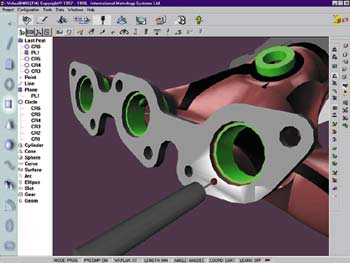|
|
|
|
Today's Specials |
|
|
|
|
Article

Demystifying DMIS This unique communication standard is changing the way we use CMMs. by Keith Mills |
The Consortium for Advanced Manufacturing International created the Dimensional Measuring Interface Standard (DMIS) to enable coordinate measuring machines (CMMs) to communicate seamlessly with each other. Traditionally, each CMM manufacturer developed its own programming language and embedded it within its measuring-application software. Many CMM producers offered more than one software package, and each utilized a unique programming language. As a result, most installed CMMs (sometimes even those from the same vendor) were unable to execute each other's inspection part programs. DMIS development began in February 1985 as the Dimensional Measuring Interface Specification Project. Users and suppliers of dimensional measuring equipment combined efforts to create a standard that would allow the communication of inspection data between automated systems. The first version, DMIS 1.0, was completed in March 1986, and DMIS 2.0 followed in September 1987. The American National Standards Institute (ANSI) accepted DMIS 2.1 as ANSI/CAM-I 101-1990 and likewise accepted DMIS 3.0 in 1995. The acknowledgments listed in the standard now read like a Who's Who of global manufacturing corporations and measuring equipment suppliers. DMIS, which references six other standards, has truly become the CMM-users' standard. DMIS was originally designed to provide a means of transferring CMM programs from a computer-aided design and computer-aided manufacturing (CAD/CAM) environment to a CMM, independent of the vendor at either end. It's essentially a standard for the two-way communication of inspection data between computer systems and inspection equipment. DMIS provides a readable and writable vocabulary of terms, establishing a neutral format for the preparation of inspection programs and results data. This vocabulary can also function as a programming language. Although some of the truly global manufacturing companies that were deeply involved in creating the standard use DMIS, its profile and general use have been somewhat limited. DMIS may have been ahead of its time; only in recent years has the use of CAD data become a major functional demand upon CMM software. Perhaps the equipment suppliers' contributions and initial involvement was due more to customer pressure than to the suppliers' commitment to embed the standard into their ongoing product development strategies. The CMM industry's consolidation in the past decade may also have shifted development strategies more toward rationalizing products than toward developing new products and capabilities. It is certain that DMIS' biggest obstacle came from a U.S. patent issued in 1993 to a now-defunct CMM manufacturer for "using a communication protocol as a programming language." At that time, DMIS was being used only as a communication protocol, and the patent stopped the development of DMIS as a programming language overnight. However, the dual usage became public domain in 1995, and DMIS has been gathering momentum ever since. Although the patent halted DMIS' uptake and provided a reason for equipment suppliers to hold off new software development via a full DMIS implementation, it did identify that DMIS 2.1 was a truly comprehensive standard. This recognition enabled it to become a programming language in its own right. The breakthrough in DMIS usage eradicated the need to provide pre- and post-processors to convert DMIS at the CMM into the vendor-specific CMM languages. Native DMIS, as it has become known, is the use of DMIS as the CMM programming language and is widely accepted as the future of CMM software. Many of the world's leading global manufacturing companies participate in the North American DMIS Users Group or the European DMIS Users Group and meet on a regular basis in the interest of advancing the DMIS standard. DMIS is expected to become an ISO standard in the near future, and DMIS 4.0 nearing its release. With CAD penetrating all facets of manufacturing and global pressure increasing for manufacturers to reduce their new product development and production times, sophisticated production companies and their supplier bases have made the creation of CMM part programs that use CAM tools their focal point. One of the original goals of the DMIS standard was to transfer these offline-generated programs in a neutral format so that they could subsequently be run on any brand of CMM. Graphical offline programming allows the generation of inspection programs in a virtual digital manufacturing environment away from the CMM. It also enables full CMM and probe kinematic simulation and program verification/optimization in advance of part production, thereby reducing lead-times and increasing CMM productivity. DMIS offers the following advantages:
The CMM software industry is currently undergoing a transformation as CMM vendors offer DMIS translators for their existing non-DMIS software packages. Few of these translators offer DMIS-Out, focusing instead only on the DMIS-In, which allows for the offline CAD programming link. The problems inherent in any translation are best demonstrated by CMM software that has DMIS Export-Out and DMIS Import-In capabilities. As the CMM reads in its own exported DMIS, the result can be surprisingly bad. This poor performance has given DMIS a bad name. Also unfortunate is the common use of brand-specific DMIS, which is created when a CMM software supplier modifies DMIS to fit into an existing product. "Flavored" DMIS is not DMIS, and it shouldn't be used. Although the next-generation CMM software currently in development will most likely embrace the full DMIS standard, some manufacturers continue to claim that DMIS doesn't provide adequate power for the more sophisticated metrology applications. Such claims are usually made by misinformed sales representatives trying to sell obsolete software rather than satisfy their customers' needs. One new-generation CMM software product that fully utilizes DMIS 3.0 in its native format is Virtual DMIS from Koh Research Foundation (KRF), available through International Metrology Systems. Virtual DMIS eliminates the need for translators and provides a seamless real-time two-way DMIS data exchange between CAD/CAM and CMM measuring systems. The DMIS 3.0 written standard comprises 389 pages and is not an easy read for a novice programmer. The Virtual DMIS development team's challenge was to harness the power of DMIS while preventing it from becoming a training nightmare and a language with which only the most high-end CMM programmers and users could work. KRF has iconized the DMIS standard, eliminating the requirement for the CMM programmer to write high-level code. Picture-programming in a vertical format provides a smart, friendly program interface and allows simplified program editing through cutting, pasting, copying and insertion functions. A double-click on a DMIS icon opens the DMIS window, displaying the underlying DMIS code. Children are taught to read before they learn to write, and the same principle is employed in Virtual DMIS. Its complete user interface utilizes DMIS terminology, which is in the form of easily decipherable abbreviations. As Microsoft iconized the DOS operating system with Windows, allowing the world to become PC-literate, the iconization of DMIS will dramatically change the uptake of DMIS. Virtual DMIS is both an offline and online product that runs the CMM, enabling users to generate and simulate programs at their desks while allowing practical program verification on the shop floor and ensuring that modified programs are seamlessly available at both locations. This flexibility and range of applications is a first in the CMM industry. Because DMIS is based on a solid model CAD engine, users can pick nominal feature geometry directly from the CAD model. With a couple of mouse clicks, Virtual DMIS provides automatic measurement and program creation simultaneously. CAD-based metrology is bringing a ten-fold productivity resolution to the CMM operation, dwarfing the CMM mechanical frame speed and acceleration enhancement upon which CMM manufacturers have been so focused in past years. This new level of productivity is one reason that it has become so popular to upgrade existing installed CMMs instead of purchasing new equipment. A Virtual DMIS retrofit can be added to a manual CMM for less than $15,000 or to a CNC CMM for about $40,000, a fraction of the cost of a new CMM. Online Virtual DMIS help contains most of the DMIS standard, including programming syntax, and can be cut and pasted directly to a program in creation. Although this is a tool for the more advanced programmer, it's a good example of the tools being built into the next generation of CMM software products to further productivity. Although all existing systems can't be replaced overnight, DMIS is changing the CMM-user's world. Buying a new CMM or upgrading an existing CMM today without DMIS is like buying a PC without a network card. You need your CMM to function not as an island but as an integral link in the ever more complex manufacturing chain. About the author Keith Mills is president of International Metrology Systems in Livonia, Michigan. He is the former president of Digital Electronic Automation, an original contributor to the DMIS specification, and was involved in the passing of the DMIS patent into the public domain. He can be reached by telephone at (888) 426-6364 or by e-mail at kmills@qualitydigest.com . |
Menu Level Above
This Menu LeveL
Menu Level Below
Copyright 1999 QCI International. All rights reserved.
Quality Digest can be reached by phone at (530) 893-4095. E-mail: Click Here


